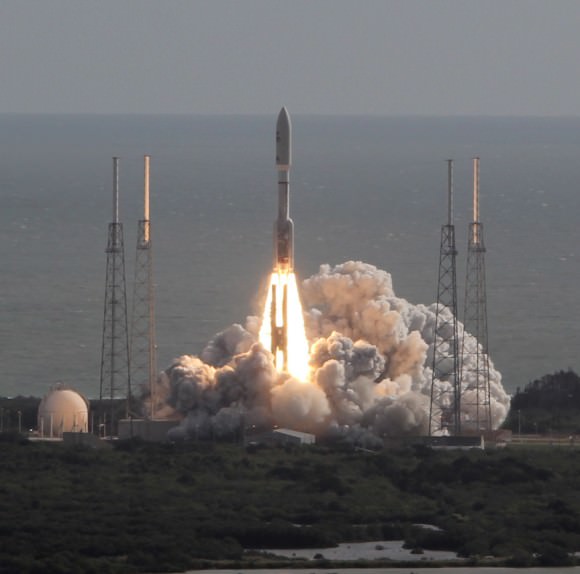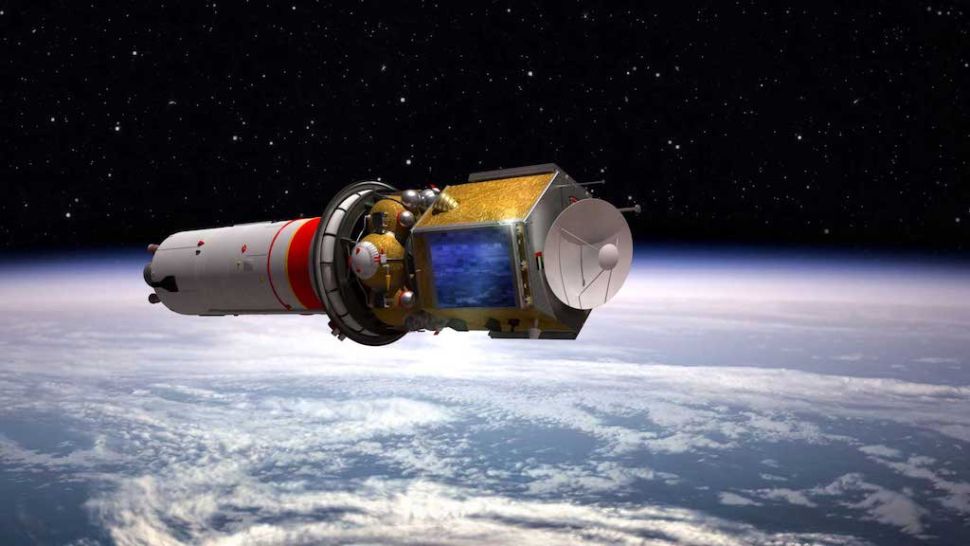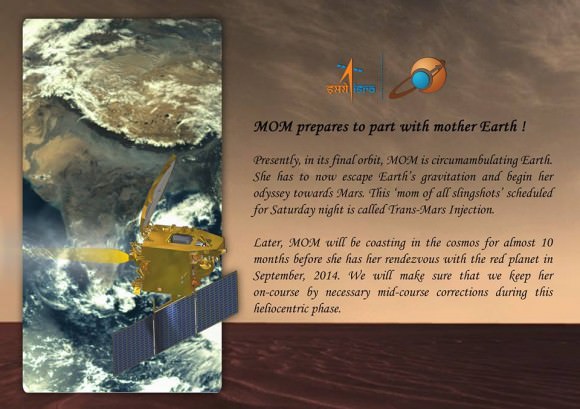On July 19th, 2020, the Emirates Mars Mission (EMM) – aka. Al Amal (“Hope” in Arabic) – launched from the Tanegashima Space Center in Japan on its way to Mars. This mission, the first interplanetary effort to be mounted by an Arab nation, is being carried out by the Mohammed bin Rashid Space Centre (MBRSC) in the United Arab Emirates (UAE) in collaboration with a number of research institutions internationally.
Continue reading “Emirates Mars Mission Arrives at the Red Planet Today!”NASA’s MAVEN Orbiter Discovers Solar Wind Stripped Away Mars Atmosphere Causing Radical Transformation

NASA’s Mars Atmosphere and Volatile Evolution (MAVEN) orbiter mission has determined that ancient Mars suffered drastic climate change and lost its thick atmosphere and surface bodies of potentially life giving liquid water because it lost tremendous quantities of gas to space via stripping by the solar wind, based on new findings that were announced today, Nov. 5, at a NASA media briefing and in a series of scientific publications.
The process of Mars dramatic transformation from a more Earth-like world to its barren state today started about 4.2 Billion years ago as the shielding effect of the global magnetic field was lost as the planets internal dynamo cooled, Bruce Jakosky, MAVEN principal investigator at the Laboratory for Atmospheric and Space Physics (LASP) at the University of Colorado, Boulder, told Universe Today.
The radical transformation of ancient Mars from a warm world with significant bodies of standing water that could have supported life, to its current state as a cold, arid and desert-like world that’s rather inhospitable to life was caused by the loss of most the planet’s atmosphere as powerful streams of solar wind particles crashed into it and stripped it away due to the loss of the protective magnetic field as the planets core cooled.
“We think that the early magnetic field that Mars had would have protected the planet from direct impact by the solar wind and would have kept it from stripping gas off,” Jakosky told me.
“So it would have been the turn off of the magnetic field, that would have allowed the turn on of stripping of the atmosphere by the solar wind.”
“The evidence suggests that the magnetic field disappeared about 4.2 Billion years ago.”
The period of abundant surface water actively carving the Martian geology lasted until about 3.7 Billion years ago. The loss of the atmosphere by stripping of the solar wind took place from about 4.2 to 3.7 Billion years ago.
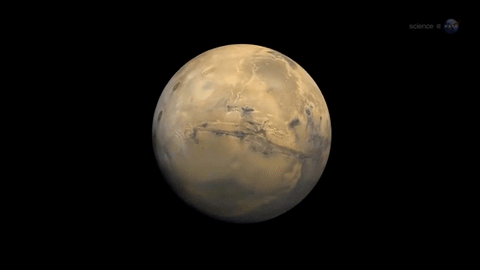
With the release of today’s results, the MAVEN science team has accomplished the primary goal of the mission, which was to determine how and why Mars lost its early, thick atmosphere and water over the past four billion years. The atmosphere is composed mostly of carbon dioxide.
Since water is a prerequisite for life as we know it, determining its fate and longevity on Mars is crucial for determining the habitability of the Red Planet and its potential for supporting martian microbes, past of present if they ever existed.
“The NASA Mars exploration program has been focused on finding water,” said Michael Meyer, lead scientist for the Mars Exploration Program at NASA Headquarters.
“Water is the prime ingredient needed for life. It is a major factor in the climate and for shaping geology. And it is a critical resource for future human exploration.”
NASA’s goal is to send humans on a ‘Journey to Mars’ during the 2030s.
This NASA video shows a visualization of the solar wind striking Mars:
Video caption: Created using data from NASA’s Mars Atmosphere and Volatile Evolution (MAVEN) mission, this visualization shows how the solar wind strips ions from the Mars’ upper atmosphere into space. Credits: NASA-GSFC/CU Boulder LASP/University of Iowa
MAVEN arrived in orbit at Mars just over one year ago on Sept. 21, 2014.
The $671 Million MAVEN spacecraft’s goal is to study Mars tenuous upper atmosphere in detail for the very first time by any spacecraft and to explore the mechanisms of how the planet lost its atmosphere and life giving water over billions of years as well as determine the rate of atmospheric loss.
The new MAVEN data have enabled researchers to measure the rate of Mars atmospheric loss of gas to space via the action of solar wind stripping as well as the erosional effect of solar storms.
Based on measurements from MAVEN’s suite of nine state-of-the-art scientific instruments, the solar wind is stripping away gas at a rate of about 100 grams (equivalent to roughly 1/4 pound) every second today, in the form of carbon dioxide and oxygen, said David Brain, MAVEN co-investigator at LASP.
“Most of the stripping [of the Martian atmosphere] by the solar wind at Mars was thought to have taken place very early in the history of the solar system when the sun was much more active and when the solar wind was more intense. So today the rate of loss at Mars is low,” Jakosky said at the briefing.
“Today’s Mars is a cold dry desert-like environment. The atmosphere is thin and it’s not capable of sustaining liquid water at the surface today, it would freeze or evaporate very quickly. However when we look at ancient Mars we see a different type of surface, one that had valleys that looked like they were carved by water and lakes that were standing for long periods of time. We see an environment that was much more able to support liquid water.”
The MAVEN results were published today in nearly four dozen scientific papers in the Nov. 5 issues of the journals Science and Geophysical Research Letters.
I asked Jakosky; How much gas would have been lost from ancient Mars and what is the rough estimate for the ancient rate of loss to arrive at Mars thin atmosphere today?
“For the amount of gas that we think you would have to have been removed – let me start with the current Mars atmosphere which has a thickness of 6 millibars, that’s just under 1% as thick as the Earth’s atmosphere,” Jakosky replied.
“So we think you would have to remove an amount of gas that is about equivalent to what’s in Earth’s atmosphere today.”
“So the rate would have to have been a factor of about 100 to 1000 times higher, than today’s loss of 100 grams per second in order to have removed the gas early in that time period, which is consistent with what the models have predicted that the loss rate would have been back then in early history.”
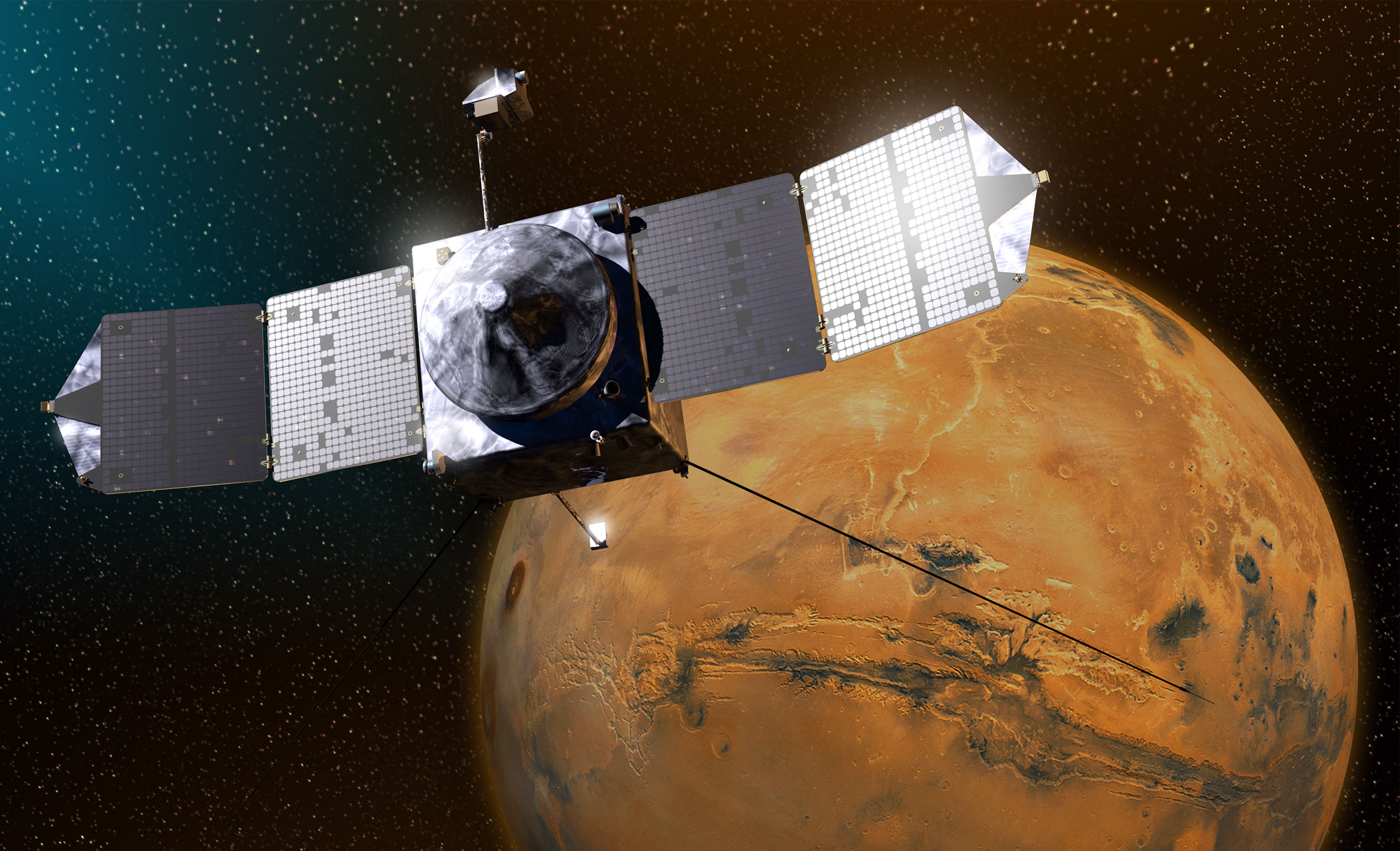
What is the solar wind and how does it strip away the atmosphere?
“The solar wind is a stream of particles, mainly protons and electrons, flowing from the sun’s atmosphere at a speed of about one million miles per hour. The magnetic field carried by the solar wind as it flows past Mars can generate an electric field, much as a turbine on Earth can be used to generate electricity. This electric field accelerates electrically charged gas atoms, called ions, in Mars’ upper atmosphere and shoots them into space,” according to a NASA description.
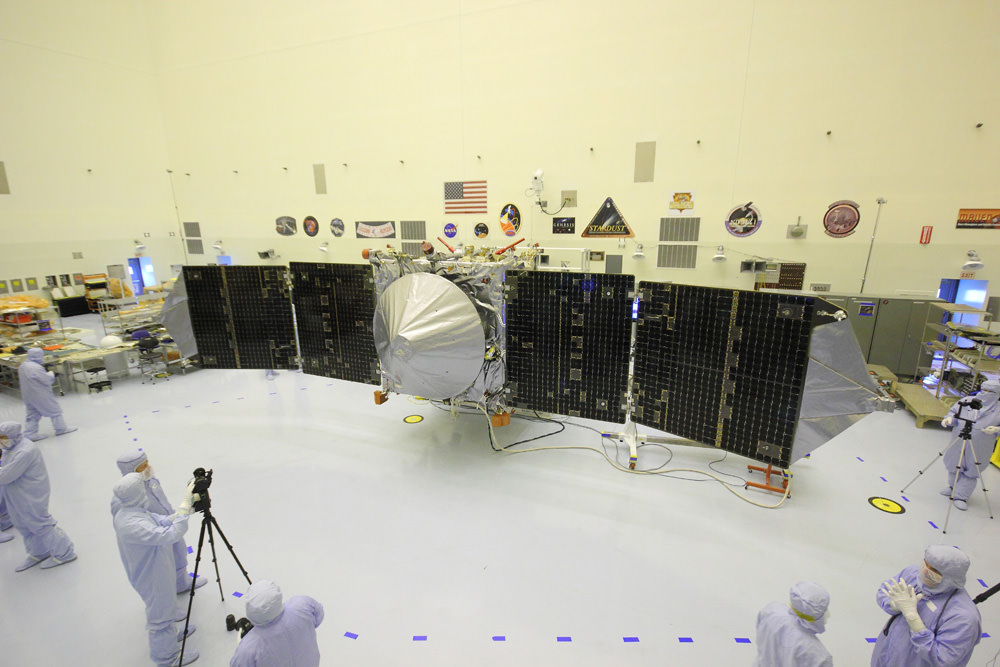
MAVEN is just now completing its primary mission and starts the extended mission phase on Nov. 16.
The 5,400 pound MAVEN probe carries nine sensors in three instrument suites to study why and exactly when did Mars undergo the radical climatic transformation.
MAVEN’s observations will be tied in with NASA’s ongoing Curiosity and Opportunity surface roving missions as well as MRO and Mars Odyssey to provide the most complete picture of the fourth rock from the sun that humanity has ever had.
MAVEN thundered to space on Nov. 18, 2013 following a flawless blastoff from Cape Canaveral Air Force Station’s Space Launch Complex 41 atop a powerful United Launch Alliance Atlas V rocket.
Stay tuned here for Ken’s continuing Earth and planetary science and human spaceflight news.

Mother of All Slingshots Set to Hurl India’s MOM Probe to Mars
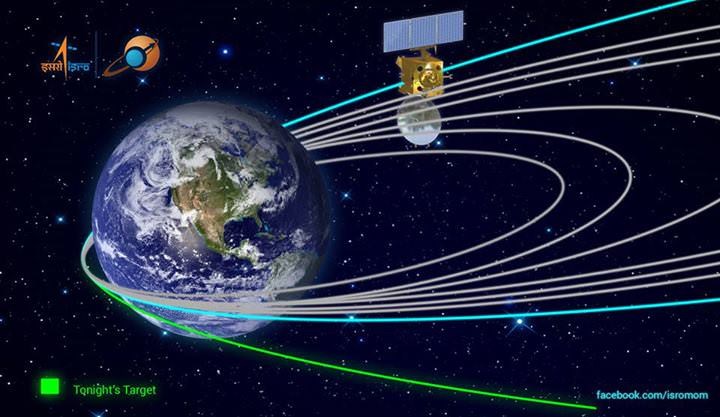
CAPE CANAVERAL, FL – MOM – India’s first ever interplanetary spacecraft – is spending her last day around Mother Earth.
The clock is ticking down relentlessly towards “The mother of all slingshots” – the critical engine firing intended to hurl India’ Mars Orbiter Mission (MOM) probe on her ten month long interplanetary cruise to the Red Planet.
Engineers at the Indian Space Research Organization’s (ISRO) Mission Operations Complex at Bangalore are now just hours away from sending the commands that will ignite MOMs’ liquid fueled main engine for TMI – the Trans Mars Insertion maneuver that will propel MOM away from Earth forever and place the craft on an elliptical trajectory to the Red Planet.
“Performance assessment of all subsystems of the spacecraft has been completed,” reports ISRO.
The do or die 1351 second burn is slated to begin at 00:49 hrs IST tonight – on Dec. 1 Indian local time.
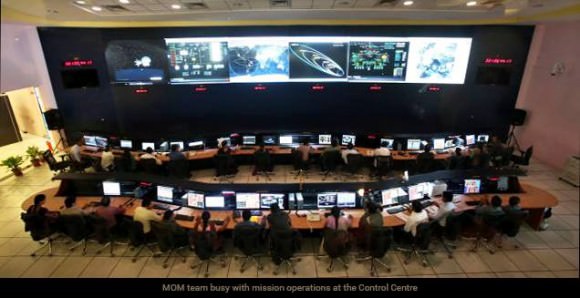
The 440 Newton liquid fueled main engine must fire precisely as planned to inject MOM on target to Mars.
MOM’s picture perfect Nov. 5 liftoff atop India’s highly reliable four stage Polar Satellite Launch Vehicle (PSLV) C25 from the ISRO’s Satish Dhawan Space Centre SHAR, Sriharikota, precisely injected the spacecraft into an initial elliptical Earth parking orbit of 247 x 23556 kilometers with an inclination of 19.2 degrees.

Since then the engine has fired 6 times to gradually raise the spacecrafts apogee.
The most recent orbit raising maneuver occurred at 01:27 hrs (IST) on Nov 16, 2013 with a burn time of 243.5 seconds increased the apogee from 118,642 km to 192,874 km.
Tonight burn is MOM’s final one around Earth and absolutely crucial for setting her on course for Mars.
If all goes well the $69 million MOM spacecraft reaches the vicinity of Mars on 24 September 2014.
MOM was the first of two Earth missions to Mars launched this November.
NASA’s $671 Million MAVEN orbiter launched as scheduled on Nov. 18, from Cape Canaveral, Florida and arrives at Mars on Sept. 22, 2014, about two days before MOM.
Both MAVEN and MOM’s goal is to study the Martian atmosphere, unlock the mysteries of its current atmosphere and determine how, why and when the atmosphere and liquid water was lost – and how this transformed Mars climate into its cold, desiccated state of today.
Stay tuned here for continuing MOM and MAVEN news and Ken’s MAVEN and SpaceX Falcon 9 launch reports from on site at the Kennedy Space Center press center and Cape Canaveral Air Force Station, Florida.
India’s MOM Mars Probe Images Earth’s Children Prior to Nail Biting Red Planet Insertion

CAPE CANAVERAL, FL – MOM is looking at you, kid!
And if the spectacular new image of billions of Earth’s children captured by India’s Mars Orbiter Mission (MOM) is any indication (see above), then we can expect absolutely gorgeous scenes of the Red Planet once the groundbreaking probe arrives there in September 2014.
But despite all that’s been accomplished so far, the space drama is still in its infant stages – because MOM still needs to ignite her thrusters this weekend in order to achieve escape velocity, wave good bye to Earth forever and eventually say hello to Mars!
The picture – snapped from Earth orbit – is focused on the Indian subcontinent, the probes origin.
MOM has captured the imagination of space enthusiasts worldwide.
And she’s the pride of all India – as the country’s first ever interplanetary space mission.
During testing of the MOM probes payloads – while it’s still flying in a highly elliptical orbit around our Home Planet – engineers from India’s space agency turned the crafts camera homewards to capture the “First ever image of Earth Taken by Mars Color Camera,” according to the Indian Space Research Organization (ISRO).
The beautiful image was taken on Nov. 20 at around 1350 hrs (IST) from a height of almost 70,000 km above earth and has a spatial resolution of 3.5 km, said ISRO.
The image also gives a rather good approximation of what MOM’s color camera will actually see from apoapsis after reaching the Red Planet since the probe will enter a similarly highly elliptical orbit around Mars – ranging in altitude from 366 kilometers (km) x 80,000 kilometers (km).
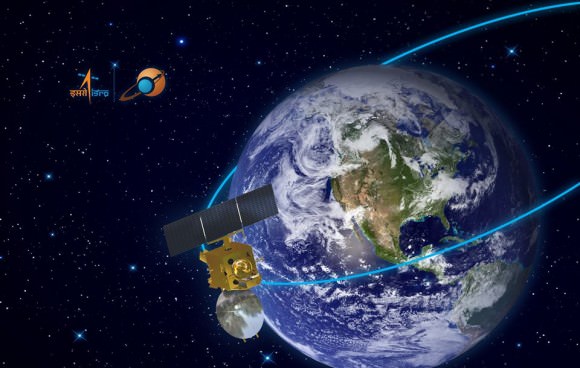
Following a 10 month interplanetary cruise, MOM is due to arrive in the vicinity of Mars on September 24, 2014 to study the Red Planets’ atmosphere.
At that time, the 440 Newton liquid fueled main engine must fire precisely as planned during the absolutely essential Mars orbital insertion burn to place the probe into orbit about Mars.
But before MOM can accomplish anything at Mars, she must first successfully fire her main engine – to complete the crucial departure from Earth and Trans Mars Insertion (TMI) scheduled for this Saturday!
MOM’s picture perfect Nov. 5 liftoff atop India’s highly reliable four stage Polar Satellite Launch Vehicle (PSLV) C25 from the ISRO’s Satish Dhawan Space Centre SHAR, Sriharikota, precisely injected the spacecraft into an initial elliptical Earth parking orbit of 247 x 23556 kilometers with an inclination of 19.2 degrees.
Since then the engine has fired 6 times to gradually raise the spacecrafts apogee.
The most recent orbit raising maneuver occurred at 01:27 hrs (IST) on Nov 16, 2013 with a burn time of 243.5 seconds increased the apogee from 118,642 km to 192,874 km.
The nail-biting final main engine burn of 1351 seconds is set for this weekend on Dec. 1. It will place MOM on a precise interplanetary trajectory to the Red Planet.
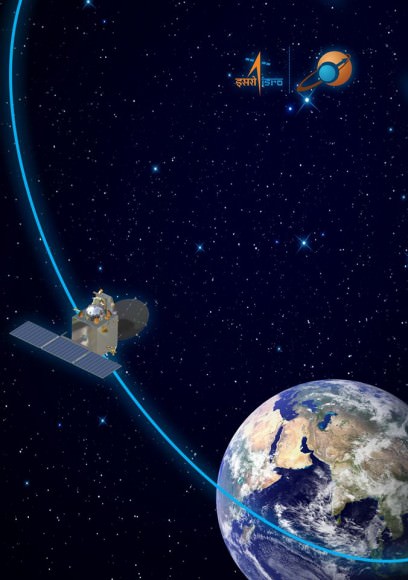
If all continues to goes well, India will join an elite club of only four who have launched probes that successfully investigated the Red Planet from orbit or the surface – following the Soviet Union, the United States and the European Space Agency (ESA).
The low cost $69 Million MOM mission is the first of two new Mars orbiter science probes from Earth that flawlessly blasted off for the Red Planet this November.
Half a world away, NASA’s $671 Million MAVEN orbiter launched as scheduled on Nov. 18 – from Cape Canaveral, Florida.
Both MAVEN and MOM’s goal is to study the Martian atmosphere, unlock the mysteries of its current atmosphere and determine how, why and when the atmosphere and liquid water was lost – and how this transformed Mars climate into its cold, desiccated state of today.
The MAVEN and MOM science teams will “work together” to unlock the secrets of Mars atmosphere and climate history, MAVEN’s top scientist Prof. Bruce Jakosky told Universe Today.
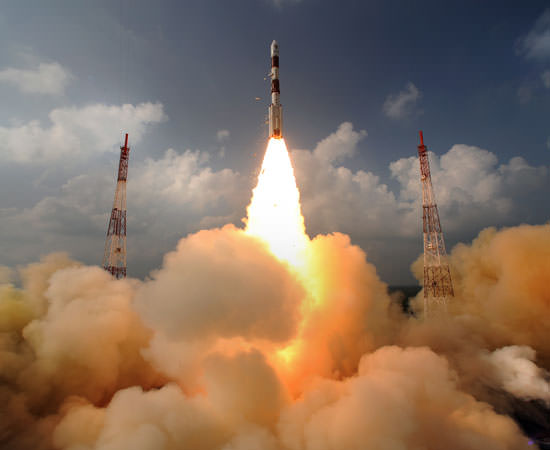
Stay tuned here for continuing MOM and MAVEN news and Ken’s MAVEN and SpaceX Falcon 9 launch reports from on site at the Kennedy Space Center press center and Cape Canaveral Air Force Station, Florida.
…………….
Learn more about MOM, MAVEN, Mars rovers, SpaceX, Orion and more at Ken’s upcoming presentations
Nov 28: “SpaceX launch, MAVEN & MOM Mars Launches and Curiosity Explores Mars, Orion and NASA’s Future”, Kennedy Space Center Quality Inn, Titusville, FL, 8 PM
Dec 11: “Curiosity, MAVEN, MOM and the Search for Life on Mars”, “LADEE & Antares ISS Launches from Virginia”, Rittenhouse Astronomical Society, Franklin Institute, Phila, PA, 8 PM
MAVEN Takes Final Test Spins, Flexes Solar Panels Before Imminent Trek to Florida Launch Site
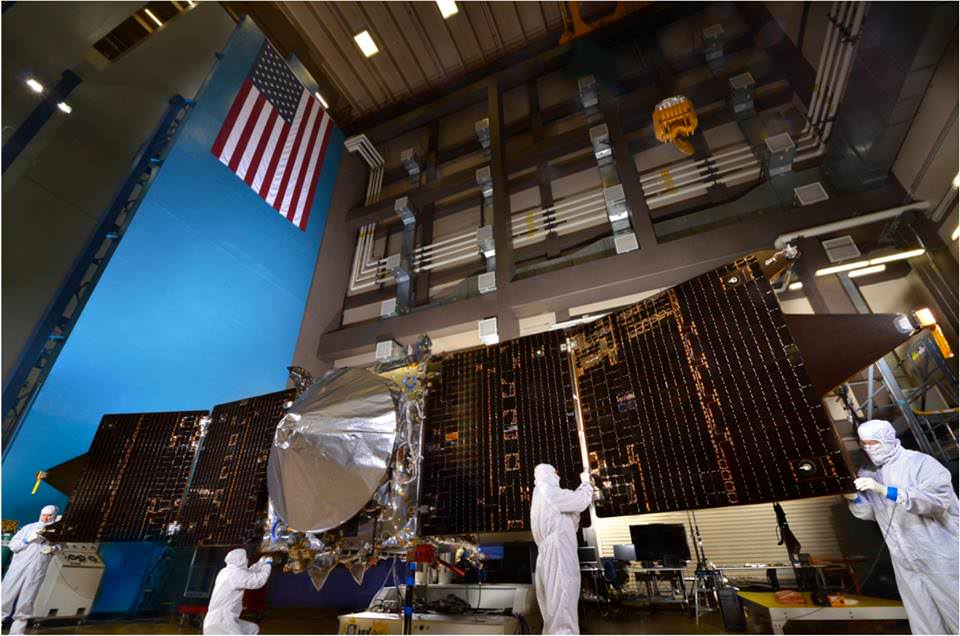
The solar panels on NASA’s MAVEN Mars orbiter are deployed as part of environmental testing procedures at Lockheed Martin Space Systems in Littleton, Colorado, before shipment to Florida on Aug. 2 and blastoff for Mars on Nov. 18, 2013. Credit: Lockheed Martin
Watch cool testing videos below![/caption]
MAVEN is NASA’s next mission to Mars and in less than three days time the spacecraft ships out on a cross country trek for the first step on the long sojourn to the Red Planet.
But before all that, technicians took MAVEN for a final spin test, flexed her solar arrays and bombarded her with sound and a whole lot more.
On Aug. 2, MAVEN (Mars Atmosphere and Volatile EvolutioN Mission) journeys half a continent from its assembly facility at Lockheed Martin in Littleton, Colorado to the Kennedy Space Center and the Florida Space Coast aboard a USAF C-17.
Unlike Curiosity, which is roving across a crater floor on the Red Planet at this very moment, MAVEN is an orbiter with a first of its kind mission.
MAVEN is the first spacecraft from Earth devoted to investigating and understanding the upper atmosphere of Mars.
The goal is determining how and why Mars lost virtually all of its atmosphere billions of years ago, what effect that had on the climate and where did the atmosphere and water go?
To ensure that MAVEN is ready for launch, technicians have been busy this year with final tests of the integrated spacecraft.
Check out this video of MAVEN’s Dry Spin Balance Test
The spin balance test was conducted on the unfueled spacecraft on July 9, 2013 at Lockheed Martin Space Systems in Littleton, Colorado.
NASA says the purpose of the test “is to ensure that the fully integrated spacecraft is correctly balanced and to determine the current center of gravity. It allows the engineering team to fine-tune any necessary weight adjustments to precisely fix the center of gravity where they want it, so that it will perform as expected during the cruise to Mars.”
It was the last test to be completed on the integrated spacecraft before its shipment to Florida later this week.
This next video shows deployment tests of the two “gull-wing” solar panels at Lockheed Martin Space Systems.
Wingtip to wingtip, MAVEN measures 11.43 m (37.5 feet) in length.
In mid May, MAVEN was moved into a Thermal Vacuum Chamber at Lockheed Martin for 19 days of testing.
The TVAC test exposed MAVEN to the utterly harsh temperatures and rigors of space similar to those it will experience during its launch, cruise, and mission at Mars.
MAVEN is slated to blast off atop an Atlas V-401 rocket from Cape Canaveral Air Force Station, Florida on Nov. 18, 2013. The 2000 pound (900 kg) spacecraft will be housed inside a 4 meter payload fairing.
After a 10 month interplanetary voyage it will join NASA’s armada of four robotic spacecraft when it arrives in Mars orbit in September 2014.
Scientists hope that measurements from MAVEN will help answer critical questions like whether, when and how long the Martian atmosphere was once substantial enough to sustain liquid water on its surface and support life.
“What we’re doing is measuring the composition of the atmosphere as a measure of latitude, longitude, time of day and solar activities,” said Paul Mahaffy, of NASA’s Goddard Space Flight Center in Greenbelt, Md, and the principal investigator for MAVEN’s mass spectrometer instrument.
“We’re trying to understand over billions of years how the atmosphere has been lost.”
…………….
Learn more about MAVEN, Cygnus, Antares, LADEE, Mars rovers and more at Ken’s upcoming lecture presentations
Aug 12: “RockSat-X Suborbital Launch, LADEE Lunar & Antares Rocket Launches from Virginia”; Rodeway Inn, Chincoteague, VA, 8 PM
Oct 3: “Curiosity and the Search for Life on Mars – (3-D)”, STAR Astronomy Club, Brookdale Community College & Monmouth Museum, Lincroft, NJ, 8 PM
